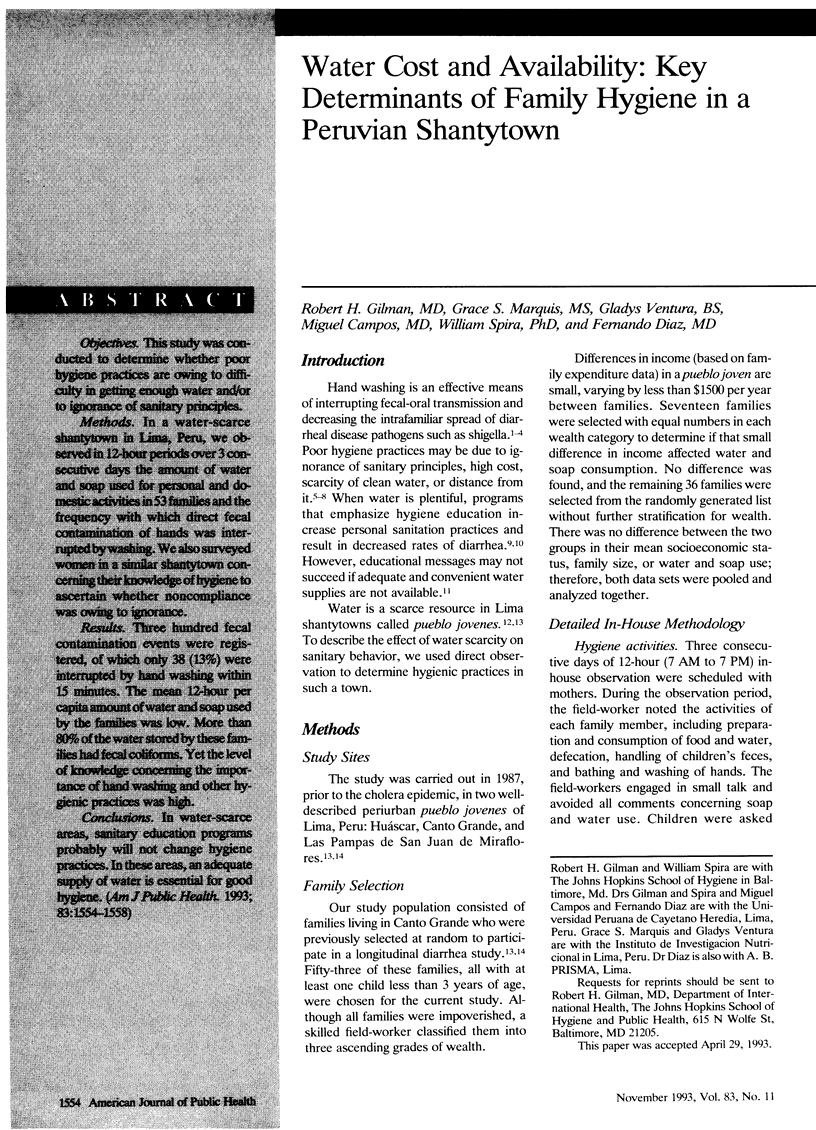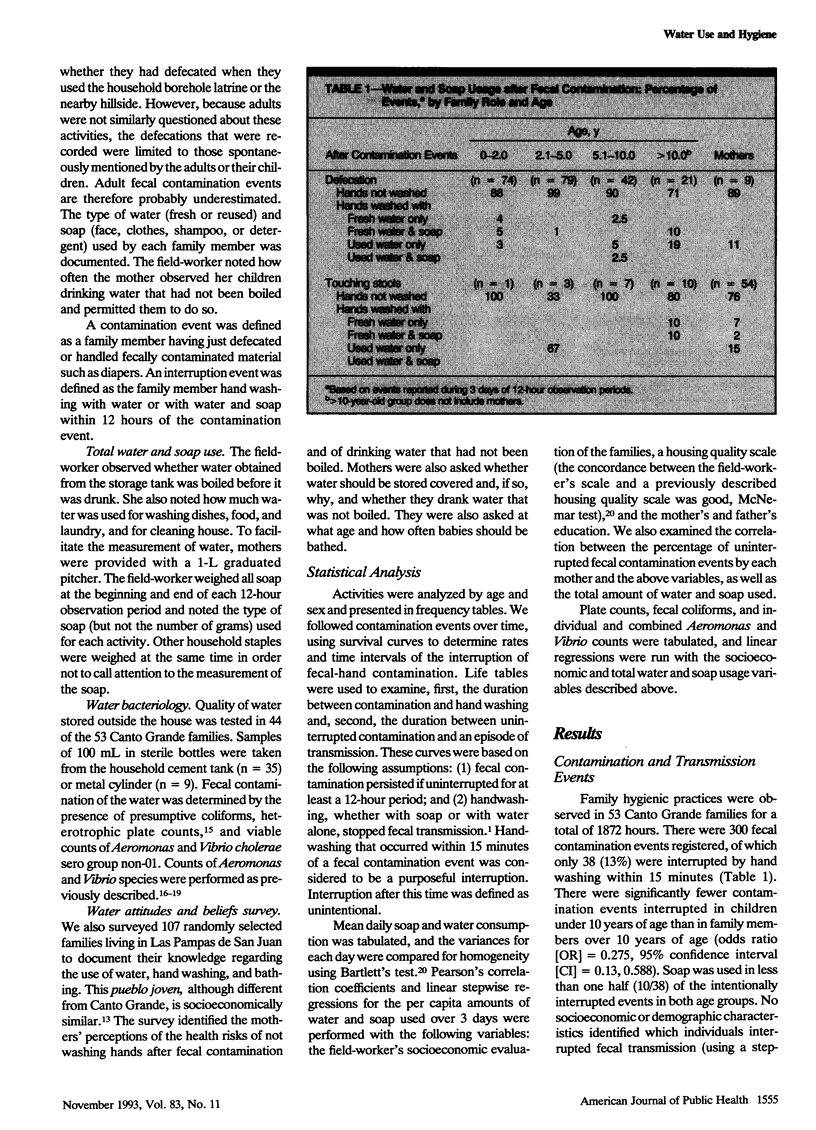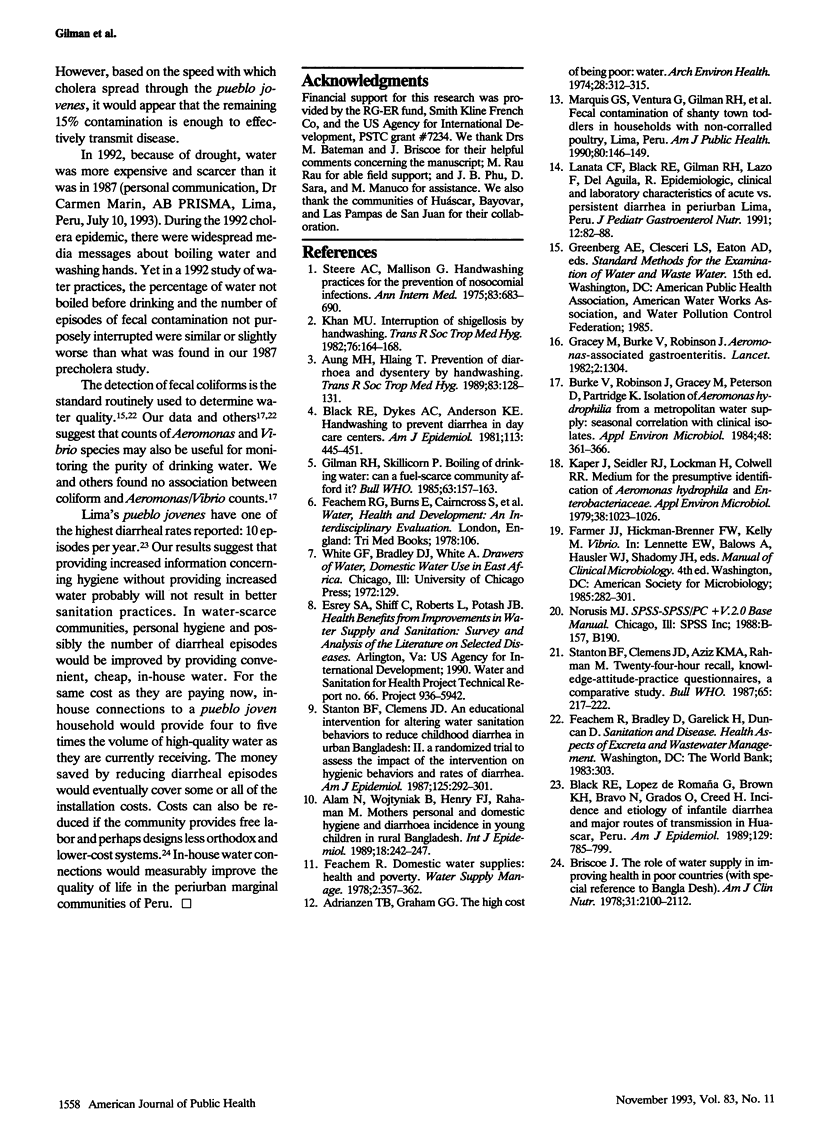Abstract
OBJECTIVES. This study was conducted to determine whether poor hygiene practices are owing to difficulty in getting enough water and/or to ignorance of sanitary principles. METHODS. In a water-scarce shantytown in Lima, Peru, we observed in 12-hour periods over 3 consecutive days the amount of water and soap used for personal and domestic activities in 53 families and the frequency with which direct fecal contamination of hands was interrupted by washing. We also surveyed women in a similar shantytown concerning their knowledge of hygiene to ascertain whether noncompliance was owing to ignorance. RESULTS. Three hundred fecal contamination events were registered, of which only 38 (13%) were interrupted by hand washing within 15 minutes. The mean 12-hour per capita amount of water and soap used by the families was low. More than 80% of the water stored by these families had fecal coliforms. Yet the level of knowledge concerning the importance of hand washing and other hygienic practices was high. CONCLUSIONS. In water-scarce areas, sanitary education programs probably will not change hygiene practices. In these areas, an adequate supply of water is essential for good hygiene.
Full text
PDF




Selected References
These references are in PubMed. This may not be the complete list of references from this article.
- Adrianzen B., Graham G. G. The high cost of being poor: water. Arch Environ Health. 1974 Jun;28(6):312–315. doi: 10.1080/00039896.1974.10666498. [DOI] [PubMed] [Google Scholar]
- Alam N., Wojtyniak B., Henry F. J., Rahaman M. M. Mothers' personal and domestic hygiene and diarrhoea incidence in young children in rural Bangladesh. Int J Epidemiol. 1989 Mar;18(1):242–247. doi: 10.1093/ije/18.1.242. [DOI] [PubMed] [Google Scholar]
- Aung Myo Han, Thein Hlaing Prevention of diarrhoea and dysentery by hand washing. Trans R Soc Trop Med Hyg. 1989 Jan-Feb;83(1):128–131. doi: 10.1016/0035-9203(89)90737-2. [DOI] [PubMed] [Google Scholar]
- Black R. E., Dykes A. C., Anderson K. E., Wells J. G., Sinclair S. P., Gary G. W., Jr, Hatch M. H., Gangarosa E. J. Handwashing to prevent diarrhea in day-care centers. Am J Epidemiol. 1981 Apr;113(4):445–451. doi: 10.1093/oxfordjournals.aje.a113112. [DOI] [PubMed] [Google Scholar]
- Black R. E., Lopez de Romaña G., Brown K. H., Bravo N., Bazalar O. G., Kanashiro H. C. Incidence and etiology of infantile diarrhea and major routes of transmission in Huascar, Peru. Am J Epidemiol. 1989 Apr;129(4):785–799. doi: 10.1093/oxfordjournals.aje.a115193. [DOI] [PubMed] [Google Scholar]
- Briscoe J. The role of water supply in improving health in poor countries (with special reference to Bangla Desh). Am J Clin Nutr. 1978 Nov;31(11):2100–2113. doi: 10.1093/ajcn/31.11.2100. [DOI] [PubMed] [Google Scholar]
- Burke V., Robinson J., Gracey M., Peterson D., Partridge K. Isolation of Aeromonas hydrophila from a metropolitan water supply: seasonal correlation with clinical isolates. Appl Environ Microbiol. 1984 Aug;48(2):361–366. doi: 10.1128/aem.48.2.361-366.1984. [DOI] [PMC free article] [PubMed] [Google Scholar]
- Gilman R. H., Skillicorn P. Boiling of drinking-water: can a fuel-scarce community afford it? Bull World Health Organ. 1985;63(1):157–163. [PMC free article] [PubMed] [Google Scholar]
- Gracey M., Burke V., Robinson J. Aeromonas-associated gastroenteritis. Lancet. 1982 Dec 11;2(8311):1304–1306. doi: 10.1016/s0140-6736(82)91510-0. [DOI] [PubMed] [Google Scholar]
- Kaper J., Seidler R. J., Lockman H., Colwell R. R. Medium for the presumptive identification of Aeromonas hydrophila and Enterobacteriaceae. Appl Environ Microbiol. 1979 Nov;38(5):1023–1026. doi: 10.1128/aem.38.5.1023-1026.1979. [DOI] [PMC free article] [PubMed] [Google Scholar]
- Khan M. U. Interruption of shigellosis by hand washing. Trans R Soc Trop Med Hyg. 1982;76(2):164–168. doi: 10.1016/0035-9203(82)90266-8. [DOI] [PubMed] [Google Scholar]
- Lanata C. F., Black R. E., Gilman R. H., Lazo F., Del Aguila R. Epidemiologic, clinical, and laboratory characteristics of acute vs. persistent diarrhea in periurban Lima, Peru. J Pediatr Gastroenterol Nutr. 1991 Jan;12(1):82–88. doi: 10.1097/00005176-199101000-00017. [DOI] [PubMed] [Google Scholar]
- Marquis G. S., Ventura G., Gilman R. H., Porras E., Miranda E., Carbajal L., Pentafiel M. Fecal contamination of shanty town toddlers in households with non-corralled poultry, Lima, Peru. Am J Public Health. 1990 Feb;80(2):146–149. doi: 10.2105/ajph.80.2.146. [DOI] [PMC free article] [PubMed] [Google Scholar]
- Stanton B. F., Clemens J. D. An educational intervention for altering water-sanitation behaviors to reduce childhood diarrhea in urban Bangladesh. II. A randomized trial to assess the impact of the intervention on hygienic behaviors and rates of diarrhea. Am J Epidemiol. 1987 Feb;125(2):292–301. doi: 10.1093/oxfordjournals.aje.a114529. [DOI] [PubMed] [Google Scholar]
- Stanton B. F., Clemens J. D., Aziz K. M., Rahman M. Twenty-four-hour recall, knowledge-attitude-practice questionnaires, and direct observations of sanitary practices: a comparative study. Bull World Health Organ. 1987;65(2):217–222. [PMC free article] [PubMed] [Google Scholar]
- Steere A. C., Mallison G. F. Handwashing practices for the prevention of nosocomial infections. Ann Intern Med. 1975 Nov;83(5):683–690. doi: 10.7326/0003-4819-83-5-683. [DOI] [PubMed] [Google Scholar]


